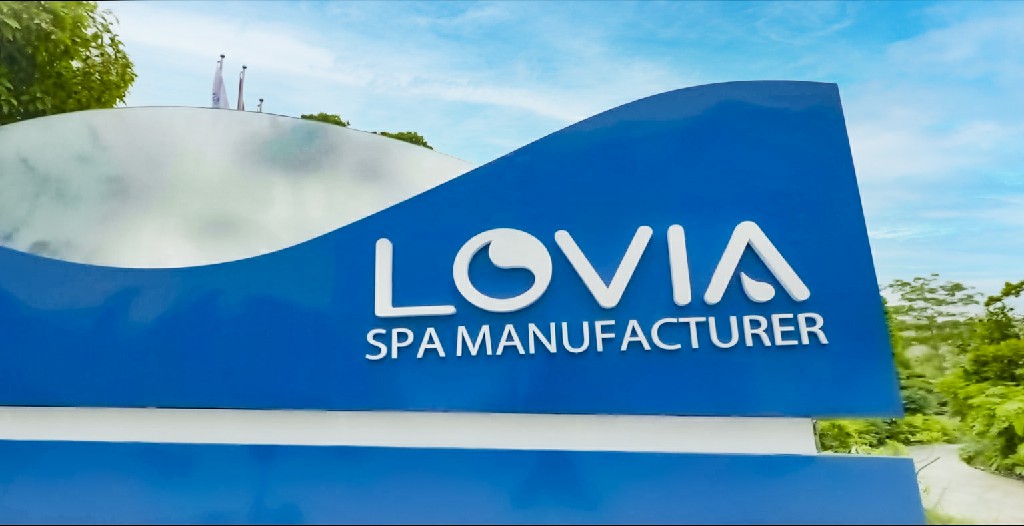
What materials are available for outdoor bathtubs?
2025-07-01 15:30As an important part of modern lifestyle, outdoor hot tubs are gradually becoming common facilities in outdoor spaces such as courtyards, balconies, and terraces. Unlike indoor bathtubs, outdoor hot tubs must not only provide a comfortable bathing experience, but also withstand multiple tests such as sun exposure, rain erosion, temperature changes, and long-term use. Therefore, it is crucial to choose an outdoor hot tub with the right material.
There are many types of outdoor hot tubs on the market, including acrylic, fiberglass, stainless steel, cast iron, wood, natural stone, concrete, artificial stone, etc. Among them, acrylic spa hot tubs are particularly common. They occupy a wide share in the high-end and mid-end markets due to their balanced performance, easy maintenance, and strong aesthetics.
This article will systematically sort out the common types of outdoor hot tub materials on the market, focusing on analyzing the performance advantages, limitations, and applicable scenarios of "acrylic hot tubs" to help readers make scientific and reasonable choices.
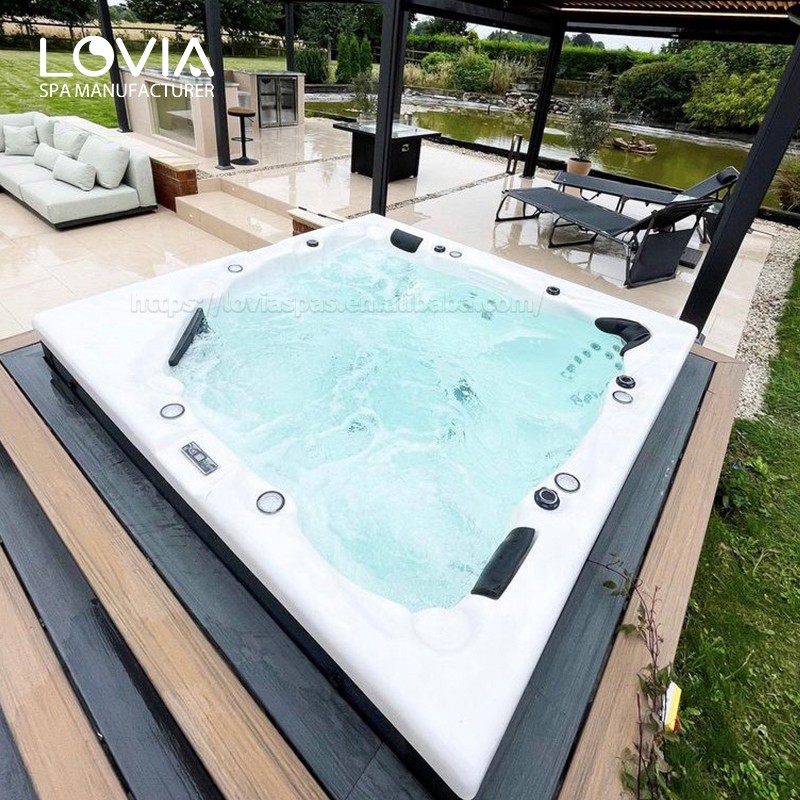
Why is the material of outdoor hot tubs important?
When using a bathtub in an outdoor environment, the use conditions are relatively harsh, and it needs to face direct sunlight, rain erosion, temperature changes, dirt deposition and other problems for a long time. If the material is not selected properly, it will not only affect the use experience, but also may cause cracking, fading, deformation, rough surface, low heating efficiency, bacteria breeding and other problems. Therefore, the reasonable selection of materials is the basis for ensuring the service life, cleaning convenience and human comfort of the outdoor hot tub.
Material selection criteria for outdoor hot tub:
· Strong UV resistance, not easy to fade and age;
· Resistant to alternating high and low temperature impact;
· Moisture-proof and mildew-proof, strong resistance to chemical corrosion;
· Smooth surface, easy to clean and maintain;
· High strength, can withstand human weight and water pressure;
· Coordinated appearance, high integration with the surrounding environment.
The above standards determine the differences in the adaptability of certain materials in outdoor environments.
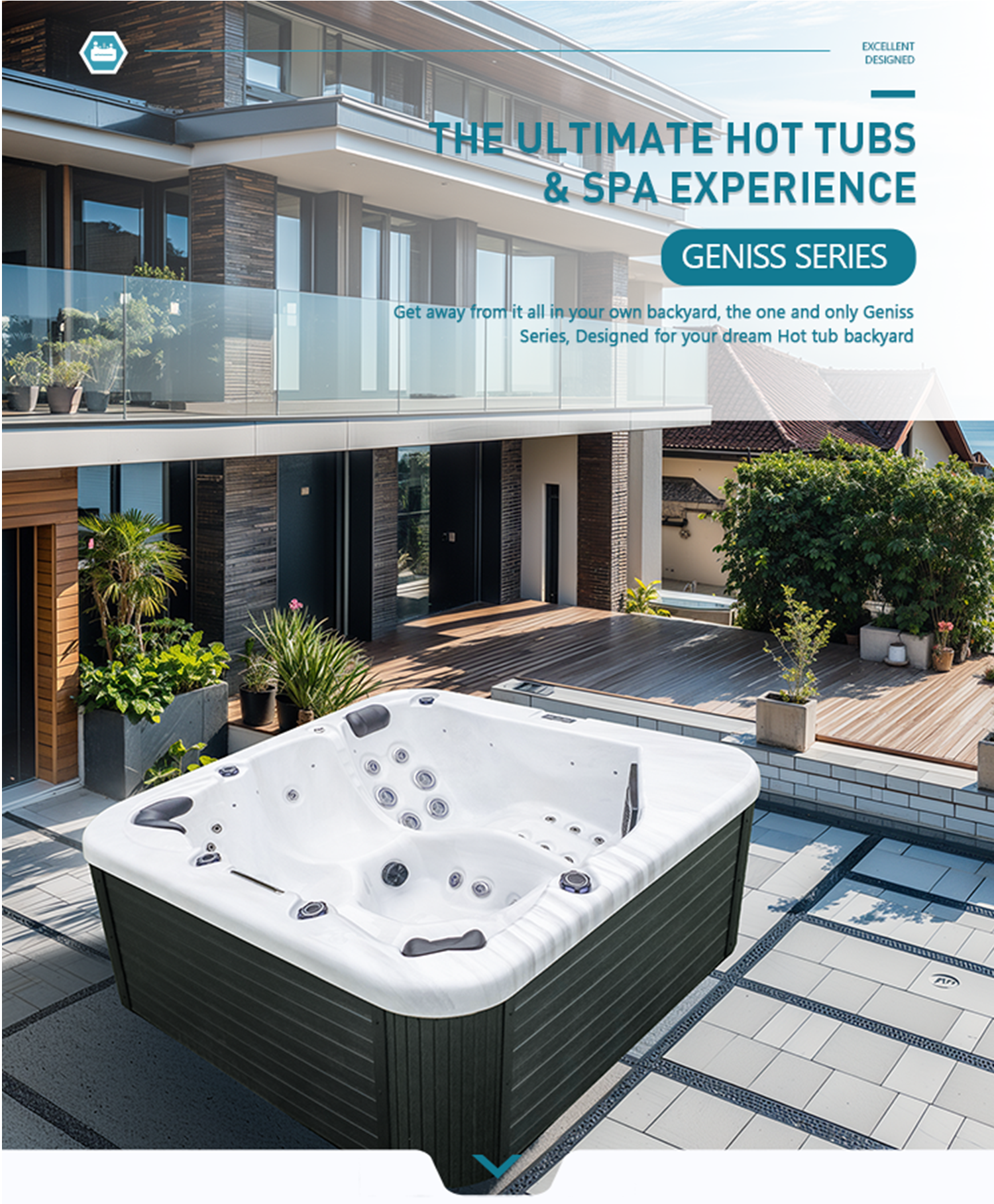
What are the common outdoor hot tub material classifications?
The following are the mainstream outdoor hot tub material types on the market:
| Tub material type | Main features |
| Acrylic tub | Good insulation, warm texture, moderate weight, diverse designs, easy to clean |
| Stainless steel tub | Modern, durable, corrosion-resistant, but fast heat conduction, easy to burn |
| Cast iron enameled tub | Traditional heavy, good insulation, but very heavy, difficult to carry |
| Fiberglass reinforced plastic (FRP) tub | Low cost, light weight, but easy to age and fade |
| Wooden tub | Natural beauty, fragrance, good insulation, but high maintenance cost |
| Stone (man-made or natural) tub | Luxury texture, durable, but expensive, very heavy |
| Concrete tub | Customizable shape, strong weather resistance, but complex installation |
| Ceramic/enamel tub | Smooth surface, but not common for outdoor use, fragile |
Among the above materials, acrylic spa hot tub has become one of the preferred materials for modern outdoor hot tubs due to its superior comprehensive performance, especially in outdoor environments.
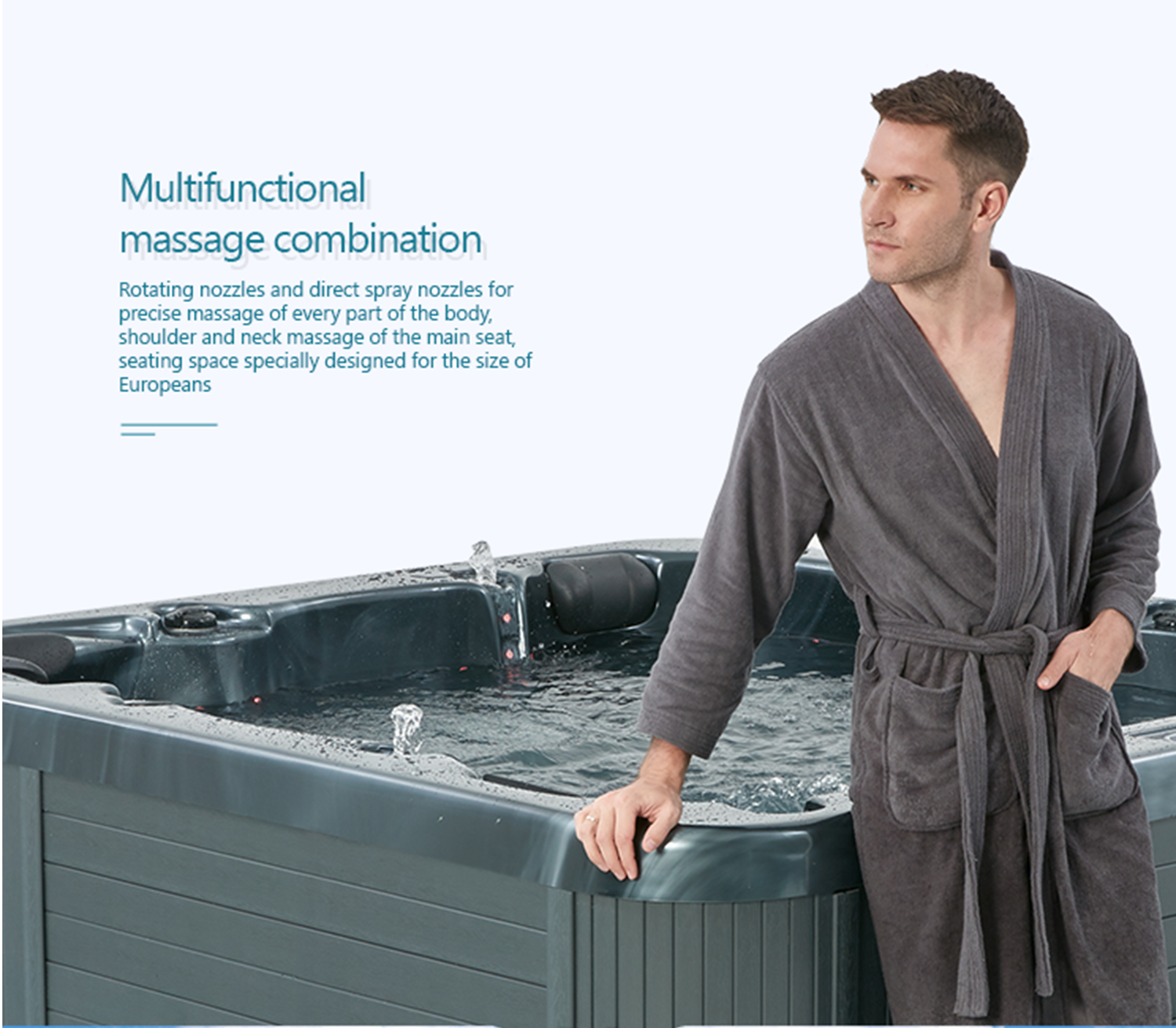
Structural characteristics and performance analysis of acrylic spa hot tub
1. What is an acrylic spa hot tub?
Acrylic hot tubs are usually made of polymethyl methacrylate (PMMA), supplemented by glass fiber reinforced bottom support, and are formed by thermoforming. Acrylic jacuzzi tubs have a smooth surface, uniform color, warm touch, and good thermal insulation and UV resistance.
In addition, the spa function of acrylic jacuzzi tub is composed of integrated technologies such as embedded jet massage system, electric water pump, heating equipment, control panel, etc., combined with the good compatibility of acrylic material, to form a systematic spa experience.
2. Main advantages of acrylic spa hot tub
(1) Excellent thermal insulation performance
Acrylic itself is a low thermal conductivity material, and its thickness and structural design can effectively reduce heat loss. Compared with metal bathtubs without insulation, acrylic spa hot tubs can maintain constant water temperature for a longer time, reduce heating energy consumption, and are particularly suitable for long-term hydrotherapy.
(2) Excellent appearance and touch
The surface of acrylic jacuzzi tub is smooth and delicate, with a variety of colors (customizable white, beige, blue-gray, etc.), with a ceramic-like luster without being cold, and soft and skin-friendly to the touch. The appearance is highly plastic and can be made into various shapes such as polygonal, oval, square, streamlined, etc.
(3) Easy to maintain and clean
Acrylic jacuzzi tub is not easy to absorb dirt and can be cleaned with ordinary neutral detergent without metal brushes or corrosive chemicals. If there are scratches on the surface, special sandpaper and polishing paste can also be used to repair it, and the service life can reach more than 10 years.
(4) Moderate weight and easy installation
Compared with cast iron, stone and other materials, acrylic spa hot tub has a light structure and is more flexible to install, which is suitable for the load-bearing requirements of spaces such as balconies, terraces, and courtyards.
(5) Strong compatibility with spa equipment
Acrylic jacuzzi tub is easy to process and drill holes, and can be flexibly embedded with nozzles, water pumps, heating pipes, lights, Bluetooth speakers and other equipment. It is one of the most adaptable materials for spa systems.
3. Limitations of acrylic spa hot tub
Although acrylic spa hot tub has significant advantages, it also has the following limitations:
· General scratch resistance: Although the surface can be repaired, it is not resistant to collisions with metal utensils or sharp scratches.
· Long-term ultraviolet irradiation will age: Although most products have anti-UV ingredients, the surface condition still needs to be checked regularly under continuous sunlight.
· Extreme temperature changes affect strength: In extremely cold or hot environments, the material may expand or shrink slightly, and attention should be paid to whether the support structure of the cylinder is stable.
Therefore, if used outdoors for a long time, it should be used with sunshade facilities, insulation covers, protective covers and other measures to extend the service life.
Comparison of acrylic spa hot tub with other outdoor hot tubs
From the perspective of comprehensive performance, acrylic spa hot tub performs well in most core indicators and is a highly cost-effective choice for outdoor use.
| Tub material type | Thermal insulation performance | UV resistance | Weight | Aesthetics | Cleanability | Compatibility with spa systems | Cost |
| Acrylic tub | High | High | Light | High | High | High | Medium |
| Stainless steel tub | Low | High | Medium | Medium | High | Medium | Medium-high |
| Cast iron enamel tub | High | Medium | Extremely Heavy | Medium-high | Medium | Low | Medium-high |
| Fiberglass reinforced plastic (FRP) tub | Low | Medium | Light | Average | Fair | Medium | Low |
| Wooden tub | Medium | Low | Medium | High | Low | Low | Medium-high |
| Stone tub | High | High | Extremely Heavy | High | Medium | Low | High |
| Concrete tub | High | High | Extremely Heavy | High | Medium | Medium | High |
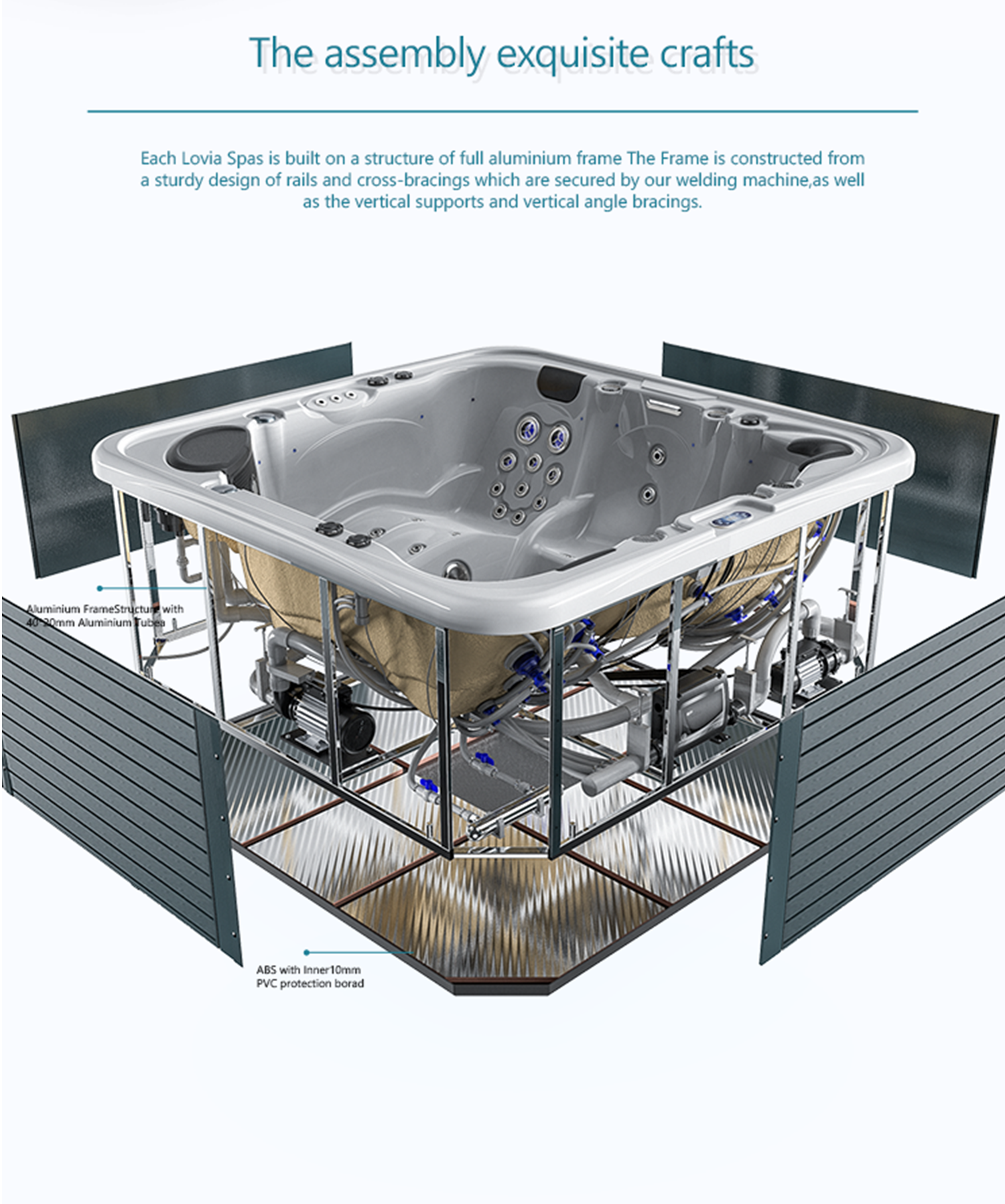
Acrylic spa hot tub usage suggestions
Based on the material properties, the following are the usage suggestions for acrylic spa hot tub:
1. Installation location suggestions:
·Acrylic spa hot tub is recommended to be installed in a semi-shaded or canopied courtyard or balcony area;
·Avoid long-term placement in an unshaded place exposed to the sun to reduce the aging rate;
·When installing the acrylic tub, check whether the ground has sufficient load-bearing capacity (especially when it is wet).
2. Maintenance suggestions:
·Rinse the surface with clean water after each use of the acrylic spa hot tub to avoid stain accumulation;
·Regularly use acrylic special cleaner to remove stubborn stains and scale;
·Check the tub nozzle and electronic control system every 3 to 6 months;
·When turning off the spa equipment, cover the bathtub with an insulation cover.
3. Suggestions for matching facilities:
·Can be matched with anti-slip mats, storage tables, cold and warm air systems, music systems, etc.;
·Use high-efficiency circulation pumps and ozone sterilization modules to improve water quality stability;
·Choose acrylic spa hot tubs with energy-saving heating systems to optimize energy consumption control.
Are your outdoor hot tubs suitable for commercial projects?
Absolutely! Our outdoor whirlpool hot tubs are designed for both residential luxury and commercial resilience. Lovia spa is one of the largest manufacturer of Outdoor Hot Tubs and swim spa in China founded in 2004,our factory in Guangzhou provides scalable production, Bulk Discounts, and Customized options. Our product series provides you with multiple options to meet your needs and budget, if any need , pls feel free to contact us Lovia spa.
